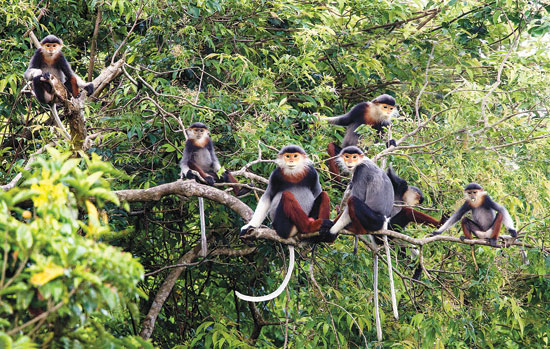No 11, Vol.5, December 2015 – January 2016

Photo: Trinh Thu Nguyet
Having five typical colours, the red-shanked douc has been crowned by the International Union for Conservation of Nature (IUCN) as the ‘queen’ of all primates. This species belongs to the IIB group of highly endangered animals in Vietnam’s Red Data Book, and is on the IUCN’s list of animals that must be unconditionally protected.
Jonathan, an American research fellow said, ‘Red-shanked doucs are very rare. I learned that among the few of their habitats in the world, Son Tra peninsula has the largest population. So I decided to come here to do research for my doctoral thesis. I focus on the life process, nutrition preferences and digestion system of these primates. I hope this will help make solutions for the protection of all the doucs in the world.’
Son Tra red-shanked doucs were discovered in 1969. At least five research groups have made field trips here for thorough study of these special primates. Many domestic and foreign filmmakers have also been here to make documentaries about them. So the image of Son Tra red-shanked doucs is already known throughout the world.
Mr Nguyen Ai Tam, lead researcher of the Green Viet Biodiversity Conservation Centre told us, ‘A special characteristic of the habits and daily life of these primates is that they live in families. We watched closely one family of five. They wake up at about 6 a.m. and start feeding. Their food includes fig fruits, banyan leaves and many other kinds of leaves available on Son Tra peninsula. After a nap from 11 a.m. to 3 p.m., they feed again.’
This species, mostly concentrated in Son Tra Natural Reserve numbers about 530 individuals, making up to 83 per cent of the world’s population. According to Douc Langur Foundation (DLF)’s data and the latest research reports of domestic experts, although the doucs face extinction elsewhere in the world, their population growth remains stable on Son Tra peninsula.
It’s been reported that before 1995, poaching, deforestation and hive burning were widespread here, driving the red-shanked doucs to near-extinction. But in recent years, the habitat of these special primates has been well protected.n
Son Tra Natural Reserve is a pristine forest with a rich, diverse and vibrant ecosystem. According to ecologists, Son Tra is currently home to 287 mammal species, 106 bird species and 15 endangered rare species that need protection, including the red-shanked doucs.
,,
,,

